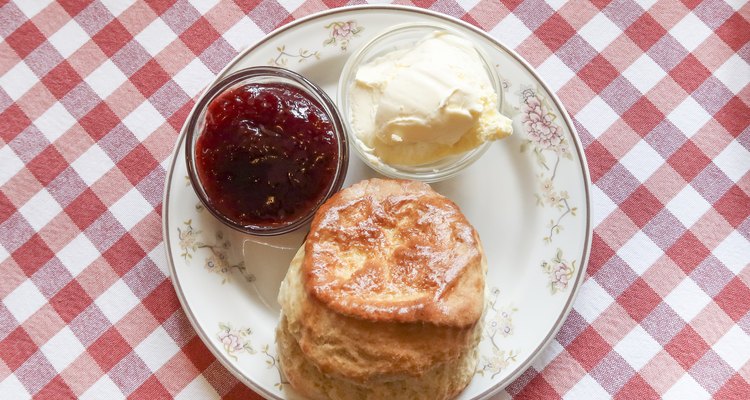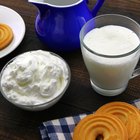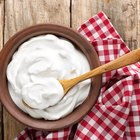
MirasWonderland/iStock/GettyImages
The counties of Devon and Cornwall, in western England, are renowned in that country for the quality of their dairy products. Two of the most famous are double cream and clotted cream, two rich and extra-thick forms of cream that are difficult to find in the United States. They're made differently, but each is thick enough to spread on scones or other baked goods.
Cream Basics
Milk is made up primarily of water, protein and globules of butterfat. If it's allowed to rest for an extended period, the fat will rise to the top just as it does in your Thanksgiving gravy. That thicker, fattier section is referred to as the cream. Modern dairies separate it in a centrifuge, adjusting the fat content for specific purposes. Coffee cream and cereal cream typically contain 20 percent fat or less. Sour cream averages about 20 percent fat, while light whipping cream has 30 to 36 percent fat, and heavy whipping cream can be as high as 40 percent.
Double Cream
If cream is left to sit at room temperature in shallow pans, it will continue to separate into lighter and heavier portions, just as the cream itself separates from milk. That's the origin of the French phrase "la creme de la creme," or the cream of the cream. If that thickest, richest portion of the cream is carefully skimmed away, it can be over 50 percent fat. At that concentration the cream is so thick it can be spread, like well-softened butter. That's called double cream, or double Devon cream in England.
Clotted Cream
If you've ever heated cream for a sauce and then let it cool, you may have noticed that it tends to solidify. That's because warmth speeds the separation of fat and softens the butterfat globules so they adhere to each other more closely. Clotted cream takes advantage of that, heating shallow pans of cream gently for up to 12 hours and then letting them cool. The surface develops a relatively stiff texture, while the rich cream underneath ranges from stiff and spreadable to smooth and custardy. It's even richer than double cream, and has a more complex flavor.
Using Spreadable Creams
Clotted cream and double cream are usually sold in jars or cans, if you're fortunate enough to live in an area where they're available as imports. Double cream has a rich, clean flavor, while clotted cream is slightly tangy and more complex. Both are superlative with fresh or preserved fruit, or spread on scones. Traditionally the English eat scones with both cream and a spoonful of jam, a memorable combination. They're difficult to make at home, but warming heavy whipping cream carefully in a yogurt maker will sometimes yield a passable version of clotted cream.
Related Articles

How Long Will Sour Cream Keep?

Different Types of Whipping Cream

How Many Calories Are in Cream of Wheat?

Cream vs. Creamer

Why Does Cream Turn Into Butter?

What Do Bakeries Use in Their Whipped ...

How to Substitute Cream for Buttermilk

Why Does Some Alcohol Curdle Cream?

Why Is My Pastry Cream Hardened?

Can You Make Instant Pudding With Heavy ...

Why Can't You Use Ultra Pasteurized ...

How to Make Scalded Cream

How Long Will Sour Cream Keep?

Benefits of Udder Cream

How to Bring Cream to a Boil

Substitutes for Clotted Cream

Can Heavy Cream Be Frozen for Later Use?

Does Cream Curdle When It Goes Bad?

How to Thicken Cream Filling

Heavy Whipping Cream Vs. Half & Half
References
- On Food and Cooking: The Science and Lore of the Kitchen; Harold McGee
- The Kitchn: What's the Difference? Clotted Cream, Devonshire Cream, Double Cream ... Plus DIY Recipes
Writer Bio
Fred Decker is a trained chef and prolific freelance writer. In previous careers, he sold insurance and mutual funds, and was a longtime retailer. He was educated at Memorial University of Newfoundland and the Northern Alberta Institute of Technology. His articles have appeared on numerous home and garden sites including GoneOutdoors, TheNest and eHow.